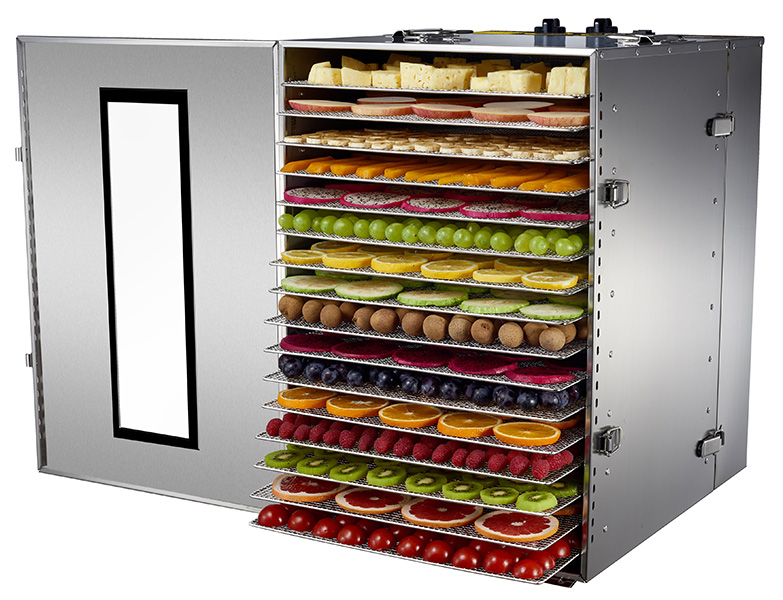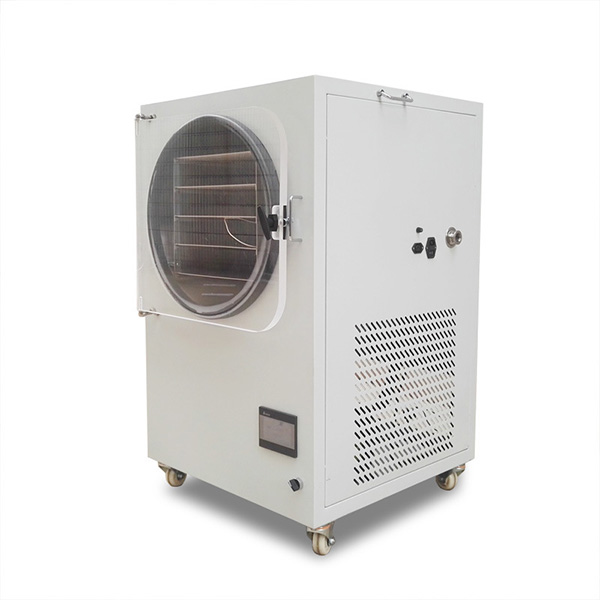
Content Menu
● Introduction to Freeze Drying
● How Freeze Drying Works
● Types of Freeze Dry Machines for Food
>> Home Freeze Dryers
>> Commercial Freeze Dryers
● Benefits of Using a Freeze Dry Machine for Food
>> Long-Term Food Storage
>> Nutritional Preservation
>> Flavor and Texture Retention
>> Lightweight and Portable
● Choosing the Right Freeze Dry Machine for Food
>> Capacity
>> Size and Space Requirements
>> Energy Efficiency
>> Ease of Use
>> Maintenance Requirements
● Popular Freeze Dry Machine Brands
>> Harvest Right
>> Labconco
>> GEA
● Using Your Freeze Dry Machine for Food
>> Preparing Food for Freeze Drying
>> Loading the Machine
>> Running the Freeze Dry Cycle
>> Storing Freeze-Dried Foods
● Innovative Applications of Freeze-Dried Foods
>> Gourmet Cuisine
>> Pet Food
>> Outdoor Recreation
>> Emergency Preparedness
● The Future of Freeze Drying Technology
● Conclusion
● Frequently Asked Questions
>> Q1: How long does freeze-dried food last?
>> Q2: Is freeze-dried food healthy?
>> Q3: Can all foods be freeze-dried?
>> Q4: How do I rehydrate freeze-dried food?
>> Q5: Are home freeze dryers worth the investment?
Introduction to Freeze Drying
Freeze drying, also known as lyophilization, is a cutting-edge food preservation method that has gained significant popularity in recent years. This process involves removing moisture from food while preserving its nutritional value, flavor, and texture. At the heart of this innovative technology is the freeze dry machine for food, a remarkable appliance that has revolutionized long-term food storage for both home users and commercial enterprises.
How Freeze Drying Works
The freeze-drying process consists of three main stages:
1. Freezing: The food is rapidly frozen to temperatures below -40°F (-40°C).
2. Primary drying: The frozen water in the food is removed through sublimation, where ice turns directly into vapor without passing through the liquid state.
3. Secondary drying: Any remaining moisture is removed through desorption, leaving the food with only 1-4% moisture content.
This process results in food that can be stored for up to 25 years while retaining most of its original nutritional value, flavor, and appearance.
Types of Freeze Dry Machines for Food
Home Freeze Dryers
Home freeze dryers have made this technology accessible to individuals and families interested in long-term food storage or creating their own freeze-dried snacks. These machines are designed for ease of use and typically have smaller capacities compared to commercial models.
Popular brands like Harvest Right offer various sizes of home freeze dryers, from small units suitable for individuals to larger models capable of processing up to 35 pounds of food per batch. These machines are ideal for those who want to preserve garden harvests, create emergency food supplies, or experiment with freeze-dried recipes.
Commercial Freeze Dryers
Commercial freeze dryers are larger, more powerful machines designed for businesses, research institutions, and large-scale food preservation operations. These units can handle significantly higher volumes of food and often come with advanced features for precise control over the freeze-drying process.
Commercial freeze dryers are essential for companies producing freeze-dried ingredients, ready-to-eat meals, and pharmaceutical products. They offer greater efficiency and consistency in output, making them suitable for high-volume production environments.
Benefits of Using a Freeze Dry Machine for Food
Long-Term Food Storage
One of the primary advantages of freeze-dried food is its exceptional shelf life. When properly packaged, freeze-dried foods can last up to 25 years without refrigeration. This makes freeze-drying an excellent option for emergency preparedness, outdoor enthusiasts, and those looking to reduce food waste.
Nutritional Preservation
Unlike other preservation methods that may degrade nutrients, freeze-drying retains most of the food's original nutritional value. Vitamins, minerals, and enzymes remain largely intact, making freeze-dried foods a healthy alternative to traditionally preserved options.
Flavor and Texture Retention
Freeze-dried foods maintain their original flavors and, when rehydrated, closely resemble their fresh counterparts in texture. This is particularly appealing for fruits and vegetables, which can be enjoyed as crispy snacks or reconstituted for use in recipes.
Lightweight and Portable
The removal of water content makes freeze-dried foods incredibly lightweight, making them ideal for camping, hiking, and space travel. NASA has long used freeze-dried foods for astronaut meals due to their low weight and long shelf life.
Choosing the Right Freeze Dry Machine for Food
When selecting a freeze dry machine for food, consider the following factors:
Capacity
Determine how much food you plan to freeze dry regularly. Home units typically process 4-35 pounds per batch, while commercial machines can handle much larger quantities.
Size and Space Requirements
Ensure you have adequate space for the machine, considering both its footprint and any additional room needed for operation and maintenance.
Energy Efficiency
Look for models with energy-saving features, as freeze dryers can consume significant amounts of electricity during operation.
Ease of Use
Consider machines with user-friendly interfaces and automated processes, especially if you're new to freeze-drying.
Maintenance Requirements
Check the maintenance needs of different models, including vacuum pump oil changes and general cleaning procedures.

Popular Freeze Dry Machine Brands
Harvest Right
Harvest Right is a leading manufacturer of home freeze dryers, offering a range of sizes to suit different needs. Their machines are known for their user-friendly design and reliable performance.
Labconco
Labconco produces both benchtop and floor-standing freeze dryers suitable for laboratory and small-scale commercial use. Their machines are valued for their precision and versatility.
GEA
GEA is a global supplier of industrial freeze-drying systems, catering to large-scale food production and pharmaceutical applications. Their machines are designed for high-volume, continuous operation.
Using Your Freeze Dry Machine for Food
Preparing Food for Freeze Drying
1. Choose fresh, high-quality ingredients.
2. Clean and slice foods into uniform pieces for even drying.
3. Pre-freeze items like sauces or soups in ice cube trays for easier handling.
Loading the Machine
1. Arrange food items in a single layer on the trays, leaving space between pieces for air circulation.
2. Avoid overloading the machine, as this can extend drying times and affect quality.
Running the Freeze Dry Cycle
1. Close the door securely and ensure a proper seal.
2. Select the appropriate cycle based on the type and quantity of food.
3. Allow the machine to complete its cycle, which can take 24-48 hours depending on the food and quantity.
Storing Freeze-Dried Foods
1. Package freeze-dried foods in airtight containers or mylar bags with oxygen absorbers.
2. Label containers with the contents and date of freeze-drying.
3. Store in a cool, dry place away from direct sunlight.

Innovative Applications of Freeze-Dried Foods
Gourmet Cuisine
Chefs are incorporating freeze-dried ingredients to add unique textures and concentrated flavors to their dishes. Freeze-dried fruits and vegetables can be used as garnishes, flavor enhancers, or reconstituted in creative ways.
Pet Food
Freeze-dried pet foods offer a convenient, nutritious alternative to traditional kibble or raw diets. These products provide pets with the benefits of raw food without the need for refrigeration.
Outdoor Recreation
Hikers, campers, and outdoor enthusiasts benefit from the lightweight, nutrient-dense nature of freeze-dried meals. These foods are easy to pack and prepare in remote locations.
Emergency Preparedness
Freeze-dried foods play a crucial role in emergency kits and long-term food storage plans. Their extended shelf life and nutritional value make them ideal for disaster preparedness.
The Future of Freeze Drying Technology
As freeze-drying technology continues to evolve, we can expect to see:
1. More energy-efficient machines with faster processing times.
2. Integration of smart technology for remote monitoring and control.
3. Expansion of freeze-dried product offerings in various industries.
4. Increased adoption of home freeze dryers as prices become more accessible.
Conclusion
Freeze dry machines for food have opened up new possibilities in food preservation, long-term storage, and culinary innovation. Whether you're a home user looking to preserve your garden's bounty or a business owner exploring new product lines, freeze-drying technology offers unique benefits that are hard to match with other preservation methods. As this technology continues to advance, we can look forward to even more exciting applications and improvements in the world of freeze-dried foods.

Frequently Asked Questions
Q1: How long does freeze-dried food last?
A1: Properly packaged freeze-dried food can last up to 25 years when stored in ideal conditions. This longevity makes it an excellent option for long-term food storage and emergency preparedness.
Q2: Is freeze-dried food healthy?
A2: Yes, freeze-dried food retains most of its original nutritional value. The process preserves vitamins, minerals, and enzymes better than many other preservation methods, making freeze-dried foods a healthy choice.
Q3: Can all foods be freeze-dried?
A3: While most foods can be freeze-dried, some are better suited to the process than others. Foods with high fat content, such as avocados, may not freeze-dry well. However, fruits, vegetables, meats, dairy products, and even entire meals can be successfully freeze-dried.
Q4: How do I rehydrate freeze-dried food?
A4: To rehydrate freeze-dried food, simply add water. The amount of water and time needed will vary depending on the food item. Generally, you'll want to use hot water for faster rehydration and let the food sit for 5-10 minutes. Some items, like freeze-dried fruits, can be enjoyed without rehydration as crispy snacks.
Q5: Are home freeze dryers worth the investment?
A5: The value of a home freeze dryer depends on your specific needs and circumstances. If you frequently preserve large quantities of food, are passionate about long-term food storage, or want to create your own freeze-dried products, a home freeze dryer can be a worthwhile investment. Consider factors such as initial cost, energy consumption, and your food preservation goals when making your decision.












